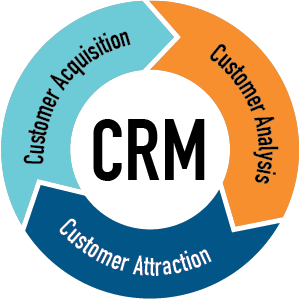Dan Smith, CMO of Outsell LLC, says understanding the needs of the customer is of paramount importance with marketing messages, because “50% of your consumers will disengage if you fail to deliver relevant content.”
 Sending “blanket” emails to your entire customer database promoting off-season combine service specials pretty much guarantee that your lawn and garden, compact tractor, hay and outdoor power equipment customers won’t read your next email. The message received is that the sender is out of touch with them, and they’re not forgiving about it.
Sending “blanket” emails to your entire customer database promoting off-season combine service specials pretty much guarantee that your lawn and garden, compact tractor, hay and outdoor power equipment customers won’t read your next email. The message received is that the sender is out of touch with them, and they’re not forgiving about it.
In another scenario, a dealer sends correspondence to Johnny Jackson, Sr., who has passed away and Johnny, Jr. has taken over the farm. Once again, the customer interprets the message as, “You don’t care.” So it is important that databases are up to date and that every marketing campaign is focused on the needs of the audience that receives them. It is time consuming to implement, both in the auto and farm equipment business, but it is critical.
In today’s environment, if customers receive any correspondence about products outside of what they’re actually interested in, they can feel deceived, which lowers their perception of the sender and what they sell. From a retailer’s standpoint, all marketing material must be sent with the attitude of “it’s something they want” and never “it’s something that we need to move.”
Smith says a good example of how a lack of customer knowledge — or the shotgun approach to marketing — can impact the perception of a company or product that a customer already knows and likes, was seen in a letter to Ford Motor Co. that appeared in Direct Marketing News.
|
“To reach potential customers with relevant product information, they must be segmented in the CRM…” |
Smith says the customer was crazy about Mustangs and bought every piece of related gear she could find, but became so upset with Ford’s marketing that she sent them these comments: “You’re kidding me, right? I expect relevancy. I couldn’t be more engaged with your brand if I tried. I followed it on Twitter. I liked it on Facebook. I’ve configured my model three or four times. I’ve told you in a thousand different ways that I love Mustangs. And you go out and hit me with an SUV ad. Why? You’re just telling me you don’t care. You’re not paying attention. You don’t value my relationship.”
To effectively reach out with focused relevant messages to growing customer bases, it is necessary to understand and utilize available CRM tools. CRM is the buzzword for, among other things, using technology to properly segment customers and focus communications to their specific needs and interests. It involves using every possible opportunity to gather and record information about each customer. As dealerships grow and touch new prospects in wider areas, it will increasingly become an essential part of the sales process.
Hunter Swift is director of sales development for Dealer Socket, a company that advises automobile dealers on improving sales through CRM tools. He believes many are missing out, because they generally only spend 5% of their advertising dollars on maintaining their base of current, loyal customers. “With properly maintained CRM,” he says, “we know name, phone number, how they want to be communicated with, every time they’ve called, emailed or texted. We know IP address, current mileage, trade value, every time they visited, every time they clicked on a link, how long they’ve been a customer and average repair order.”
Car dealers are missing so many opportunities to expand business with their existing customer base that it could represent a stand-alone business entity. “Do you know where I’d get those leads? I get them from their own CRM or dealer business system,” he says.
To reach potential customers with relevant product information, they must first be segmented in the CRM. In a farm equipment dealership, that may mean they are classified row-crop customers, hay tool customers, lawn and garden customers, outdoor power equipment customers, etc., and likely need to be broken down even further. Lawn and garden may include commercial lawn mowing contractors, homeowners with zero-turn mowers, or garden tractor or push mower owners.
Homeowners with zero turns might need to be broken down by those with smaller yards who are candidates for the $4,999 and under price point mowers and those with large acreages that want the perfect cut and are willing to pay $13,000 for a mower. Each customer needs to be put in a “bucket,” and some customers will be in multiple buckets.
But, segmenting must go even deeper. For example, there needs to be a different message depending on what stage the customer is at in the ownership process. For example, it can be a big turn off to the person who just bought his first zero turn to receive a promotional item telling him it’s time to trade for a newer and better model.
The first step in the process is to end the practice of shotgun emails that go to every person in your database. To do this, the dealership must be committed to capturing good, segmented data on each customer as the next critical step. Using it to send relevant correspondence a couple times a year, with helpful hints and news about products they use, has proven to be an effective touch point.
|
“There must be a strong emphasis on capturing information from customers and prospects…” |
This is particularly true when it’s time to trade or upgrade equipment, either because the customer let it be known to a salesperson or a technician they are shopping, or because their machine is near the age when most people trade. It’s perfectly acceptable to increase the frequency of emails that offer specials on new products and maintain it until they have acted. This process shows an interest in and knowledge of the customer’s need. It also helps them move forward in their decision-making. In the process of retaining that customer, the dealer is looked at as a friend and business partner. All of this is now part of customers’ rising expectations.
The biggest challenge in getting to this point is that it probably will require a change in the culture of the dealership where there’s a strong emphasis on capturing additional information from customers and prospective customers. Above all, getting current email addresses is absolutely critical. Swift says, “If customers call or come in, we’re only capturing 25-35% of their contact information. We’re spending $20-$50 a lead for Internet leads and we’re lucky if we get name, email and vehicle information.”
Parts and service departments must be committed to the CRM process, as well. Anytime there is interaction with a customer, it is an opportunity to gather information. How large is their farm? How many cows do they have? How old is their equipment? Equally important are their hobbies, their family situation and where they want to be in 10 years.
All of this information needs to be entered into the business system so correspondence and marketing campaigns can be tailored directly to them. In doing so, they will feel known and valued as customers.
Even with a good CRM system, the biggest challenge is the time it takes to organize the data. The new world of marketing requires that someone is continually entering and updating the information and using it to send relevant messages. Even in the middle of hay season, corn harvest and other busy times, CRM must be part of a dealership’s daily routine. The importance of getting good, thorough data into the system can’t be emphasized enough.
But, in the end, CRM can change the way dealers are perceived by their customers. Years ago when there was a farm equipment store in every town and dealers worked with a smaller customer base, owners and salesmen could know every customer’s name, pertinent information and buying habits — the sales process was much more personal. Today, with a properly managed CRM tool, dealers are able to bring back that personal touch even with a larger customer base — even with fewer salespeople per customers.







Post a comment
Report Abusive Comment